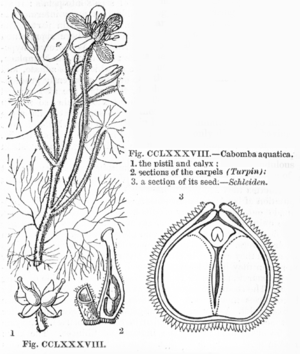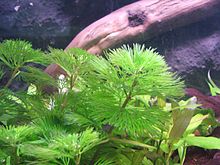Hair mermaid family
| Hair mermaid family | ||||||||||||
|---|---|---|---|---|---|---|---|---|---|---|---|---|

Illustration of the giant hair mermaid ( Cabomba aquatica ) |
||||||||||||
| Systematics | ||||||||||||
|
||||||||||||
| Scientific name | ||||||||||||
| Cabombaceae | ||||||||||||
| Rich. ex A.Rich. |
The hair mermaid family (Cabombaceae) are a small family in the order of the water lily-like (Nymphaeales) within the flowering plants (Magnoliopsida).
description
Vegetative characteristics
All species in the Cabombaceae family are perennial herbaceous plants . They are aquatic plants with branched rhizomes , all of which are anchored in the water bed with adventitious roots. There is no secondary growth in thickness . Depending on the species, clear or colored milky sap may or may not be present in the plants . The slender stems are branched.
When leaves are sorted by class: at Brasenia only floating leaves, or in the heterophyllous Cabomba exist underwater and floating leaves. The leaves are alternate and spiral, two or four lines; or arranged opposite. The leaf blade is often heart-shaped, simple or divided, in some species shield-shaped (peltat). If the leaf blade is divided - this only occurs in underwater leaves - then its ends are dichotomously divided. There are no stipules .
Generative characteristics
The flowers stand individually, laterally between the nodes (nodes) on long to short flower stalks on or above the water level. The flowers are small in relation to the water lily family (Nymphaeaceae) , hermaphroditic, radial symmetry and threefold. The flowers are mainly divided into petal circles (in contrast to the closest related family, the Nymphaeaceae, in which the flower parts are still arranged in a spiral); however, the carpels or the carpels and stamens are sometimes also arranged in a spiral. The inflorescence consists of two alternating circles. The three sepals, which are at most slightly intergrown, i.e. mostly free, are similar to the petals . The three yellow, purple or white petals have two nectaries ; they can be nailed. In Cabomba there are three to six, in Brasenia 12 to 18 or more (centripetal developing), identical, free, fertile stamens . The anthers are tetrasporangiat. The pollen grains are sulcat, sometimes trichotomosulkat, and have an aperture. The one to 22, usually three to 18 Upper constant (depending on species) carpels (carpels) are free - an original feature - but with only a few (usually two or three, one to five) ovules . The flowers are only open during the day. Pollination at Cabomba is done by insects ( flies , entomophilia ) and Brasenia is wind pollinated.
The leathery fruits, surrounded by the bracts, are similar to achaines or follicles and contain one to three seeds. The fruits can be combined to form a collective fruit. The seeds have a small endosperm. There are two fleshy seed leaves ( cotyledons formed).
distribution
They are distributed worldwide in temperate to tropical areas. They have not been at home in Europe since the Ice Age; Brasenia schreberi was found in soil layers for Europe (DW Taylor et al. 2001 and ML Taylor et al. 2008).
Systematics
The first publication of the family name Cabombaceae was in 1822 by Louis Claude Marie Richard in Achille Richard : Dictionnaire classique d'histoire naturelle , 2, p. 608. The type genus is Cabomba Aubl. A synonym for Cabombaceae Rich. ex A.Rich. is Hydropeltidaceae Dumort. For example, in Kuan Ke-chien in Flora Reipublicae Popularis Sinicae , Volume 27, 1979, pp. 5-6, it was still a subfamily Cabomboideae within the Nymphaeaceae family .
The Cabombaceae family includes two genera with six species:
-
Brasenia Schreb. : There are only flooding alternate leaves; they are simple and shield-shaped (peltat). There are usually 12 to 36 (up to 51) stamens present. The scars are elongated. With the only kind:
- Water shield or mucilaginous herb ( Brasenia schreberi J.F.Gmel. ): Home is Africa, subtropical Asia, America and Eastern Australia.
- Hair mermaids ( Cabomba Aubl. , Syn .: Hydropeltis Michx. ): The underwater leaves are opposite and divided. Flooding leaves are present during the flowering period; they are alternate, tiny and shield-shaped. There are only three to six stamens present. The scars are heady. With five species in the New World.
use
Few species are used as aquarium plants .
In China and Japan, parts of the Brasenia schreberi plant are eaten. Leaf buds in particular are eaten raw as a salad, also canned in glasses. The underground plant parts are eaten cooked. A type of flour is also produced from the underground parts of the plant. Medical effects were examined.
swell
- The family of Cabombaceae in APWebsite. (Section description and systematics)
- The Cabombaceae family at DELTA by L. Watson & MJ Dallwitz. (Section description)
- John. H. Wiersema: Cabombaceae : same text online as printed work , In: Flora of North America Editorial Committee (Ed.): Flora of North America North of Mexico , Volume 3 - Magnoliidae and Hamamelidae , Oxford University Press, New York and Oxford 1997. ISBN 0-19-511246-6 (sections description and systematics)
- Dezhi Fu, John H. Wiersema: Cabomaceae. : - same text online as the printed work , Wu Zhengyi, Peter H. Raven, Deyuan Hong (eds.): Flora of China , Volume 6 - Caryophyllaceae through Lardizabalaceae , Science Press and Missouri Botanical Garden Press, Beijing and St. Louis, 2001. ISBN 1-930723-05-9 (sections description and systematics)
Individual evidence
- ↑ a b Cabombaceae in the Germplasm Resources Information Network (GRIN), USDA , ARS , National Genetic Resources Program. National Germplasm Resources Laboratory, Beltsville, Maryland.
- ↑ a b Walter Erhardt among others: The great pikeperch. Encyclopedia of Plant Names . Volume 2. Verlag Eugen Ulmer, Stuttgart 2008. ISBN 978-3-8001-5406-7
- ↑ Brasenia schreberi at Plants For A Future

